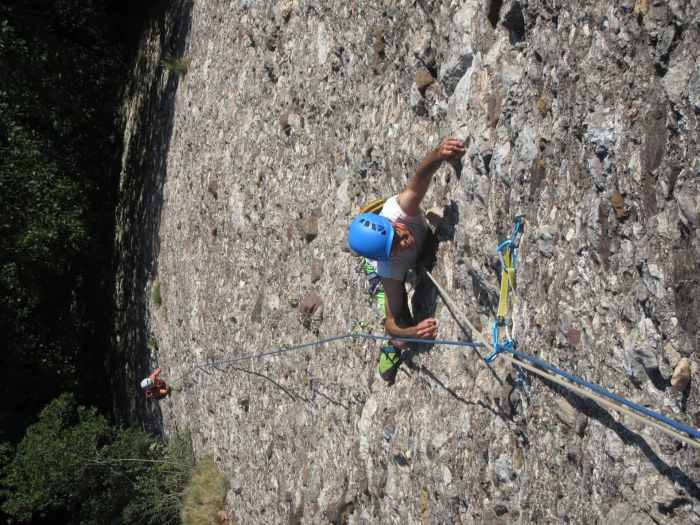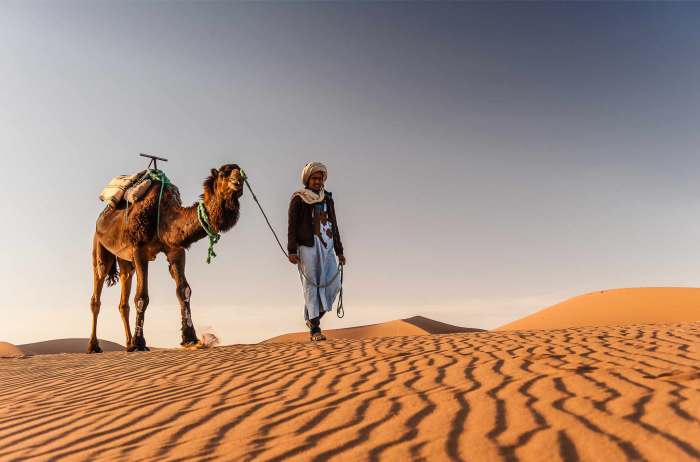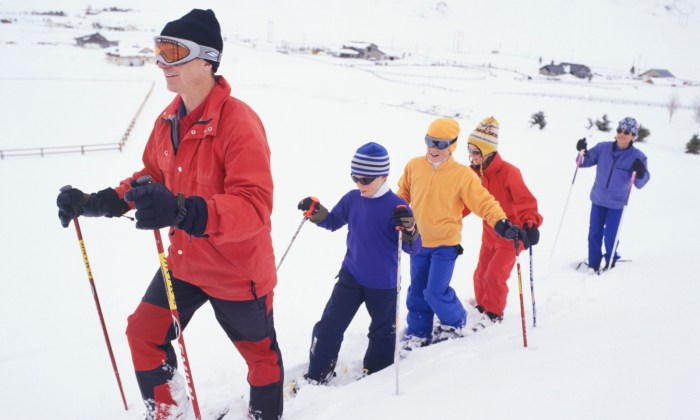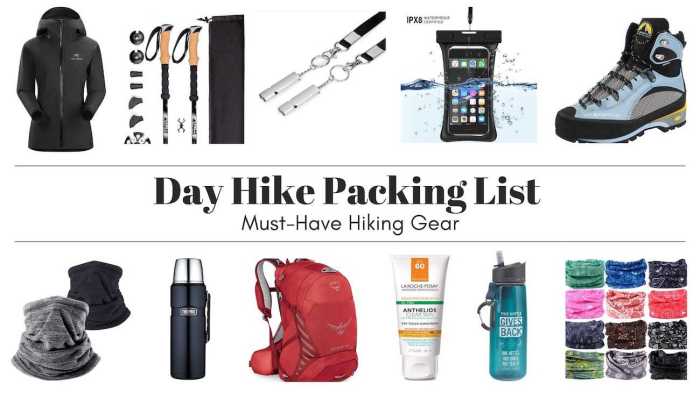
Kicking off with Hiking and Trekking Packing List, this guide will ensure you’re well-prepared for your outdoor escapades with a comprehensive list of essential items and efficient packing tips. Whether you’re trekking through mountains or hiking in diverse terrains, this packing list has got you covered.
Hiking and Trekking Packing List
When preparing for a hiking or trekking trip, it’s essential to pack wisely to ensure you have everything you need while keeping your backpack as light as possible. Here is a detailed list of essential items and tips to help you pack efficiently for varying terrains and climates.
Essential Items to Pack:, Hiking and Trekking Packing List
- Proper hiking boots with good ankle support
- Moisture-wicking clothing to keep you dry
- Waterproof and windproof jacket
- Sunscreen and sunglasses for sun protection
- Map, compass, and GPS for navigation
- First aid kit with necessary medications
- Headlamp or flashlight with extra batteries
- Multi-tool or knife for various tasks
- Food and snacks to keep your energy levels up
- Water bottles or hydration system
Tips for Efficient Packing:
- Roll your clothes to save space in your backpack
- Use packing cubes to organize your gear
- Pack lightweight and quick-drying clothing
- Choose multipurpose gear to save weight
- Consider the weather and terrain to pack accordingly
Importance of Lightweight and Multipurpose Gear:
Carrying a heavy backpack can quickly tire you out during long hikes. Opting for lightweight gear not only reduces the strain on your body but also allows you to cover more ground comfortably. Multipurpose items like a hiking pole that doubles as a tent pole or a jacket that can be used as a pillow are invaluable for saving space and weight in your pack.
Hiking and Trekking Mountain Adventures
Exploring mountainous regions through hiking and trekking offers a thrilling adventure for outdoor enthusiasts. The rugged terrain, stunning landscapes, and fresh air make it an unforgettable experience.
Popular Mountain Destinations
When it comes to hiking and trekking adventures in mountainous regions, some popular destinations stand out:
- 1. The Himalayas: Known for its majestic peaks, including Mount Everest, the Himalayas offer a challenging yet rewarding experience for trekkers.
- 2. The Andes: Stretching along the western coast of South America, the Andes provide breathtaking views and diverse terrain for hikers.
- 3. The Rocky Mountains: Located in North America, the Rockies boast stunning alpine scenery and a variety of trails for all skill levels.
Significance of Acclimatization
Acclimatization is crucial when trekking in high-altitude regions to prevent altitude sickness and ensure a safe journey. It involves giving your body time to adjust to reduced oxygen levels at higher elevations.
Proper acclimatization involves gradual ascent, staying hydrated, and listening to your body for any signs of altitude sickness.
Safety Tips for Hiking in Mountainous Terrain
When embarking on a hiking or trekking adventure in mountainous terrain, it’s essential to prioritize safety. Here are some tips to keep in mind:
- 1. Stay on marked trails: Avoid straying off designated paths to prevent getting lost or encountering dangerous terrain.
- 2. Check the weather: Be aware of weather conditions before heading out, and be prepared for sudden changes in mountainous regions.
- 3. Pack essentials: Carry necessary gear such as a map, compass, first aid kit, extra clothing, and sufficient food and water.
- 4. Inform others: Let someone know your hiking plans and expected return time, especially when venturing into remote areas.
- 5. Respect wildlife: Keep a safe distance from wildlife encounters and avoid feeding or approaching animals.
Safari and Wildlife Tours
Embarking on a safari or wildlife tour is an exciting adventure that allows you to witness incredible animals in their natural habitat. However, it is important to be well-prepared and to conduct yourself in a respectful and ethical manner during these tours.
Essential Items for Safari or Wildlife Tours
When preparing for a safari or wildlife tour, it is essential to pack the following items:
- Sunscreen and insect repellent
- Binoculars for better wildlife viewing
- Comfortable and breathable clothing
- Sturdy walking shoes
- Camera or binoculars for capturing memorable moments
- Water bottle and snacks
- First aid kit
- Guidebook or wildlife identification book
Respecting Wildlife and Following Ethical Guidelines
It is crucial to respect wildlife and follow ethical guidelines during safari and wildlife tours to ensure the well-being of the animals and the sustainability of their habitats. Remember to:
- Keep a safe distance from animals and avoid disturbing them
- Do not feed wild animals or interfere with their natural behavior
- Obey park rules and guidelines set by tour operators
- Dispose of waste properly and minimize your impact on the environment
- Support conservation efforts and responsible tourism practices
Memorable Wildlife Encounters
During safari and wildlife tours, you may have the opportunity to witness unforgettable moments in nature. Some memorable wildlife encounters include:
- Spotting a pride of lions basking in the sun
- Watching a herd of elephants peacefully grazing in the savannah
- Observing a cheetah chasing its prey with lightning speed
- Seeing a family of gorillas interacting in their natural habitat
- Witnessing a majestic herd of wildebeest during the Great Migration
Extreme Sports Travel: Hiking And Trekking Packing List
When it comes to seeking thrills and pushing the boundaries of adventure, extreme sports travel offers a unique and exhilarating experience. From skydiving to bungee jumping, extreme sports enthusiasts are always on the lookout for their next adrenaline rush.
Safety Measures and Precautions
Before engaging in extreme sports activities, it is crucial to prioritize safety. Here are some essential safety measures and precautions to consider:
- Always wear proper safety gear, including helmets, harnesses, and padding.
- Understand and follow all instructions provided by trained professionals or guides.
- Check the weather conditions and ensure they are suitable for the activity.
- Double-check all equipment and gear before starting any extreme sports activity.
- Listen to your body and know your limits – don’t push yourself beyond what you can handle.
Appeal of Extreme Sports
For adventure enthusiasts, the appeal of extreme sports lies in the adrenaline rush, the sense of accomplishment, and the opportunity to conquer fears and challenge oneself. The thrill of facing danger head-on and pushing boundaries creates a unique and unforgettable experience that many seek in their travels.
Scuba Diving Destinations
Scuba diving is an exhilarating experience that allows you to explore the wonders of the underwater world. To make the most of your scuba diving trips, it’s essential to have the right gear, seek unique underwater experiences in popular diving destinations, and follow tips to enhance your diving adventures.
Must-Have Gear for Scuba Diving Trips
- Mask and Snorkel: Essential for clear vision and easy breathing underwater.
- Wetsuit: Provides thermal protection and buoyancy while diving in different water temperatures.
- BCD (Buoyancy Control Device): Helps divers control their buoyancy and stay at the desired depth.
- Regulator: Regulates airflow from the scuba tank to ensure smooth breathing underwater.
- Fins: Aid in propulsion and maneuvering in the water.
- Dive Computer: Monitors depth, time, and nitrogen levels for safe diving.
Unique Underwater Experiences in Popular Diving Destinations
- Great Barrier Reef, Australia: Explore vibrant coral reefs, tropical fish, and marine life in the world’s largest reef system.
- Galapagos Islands, Ecuador: Encounter hammerhead sharks, sea lions, and marine iguanas in this biodiversity hotspot.
- Barracuda Point, Malaysia: Witness swirling tornadoes of barracuda and other pelagic species in the waters of Sipadan.
- Blue Hole, Belize: Dive into a giant underwater sinkhole surrounded by colorful coral formations and diverse marine species.
- Thistlegorm Wreck, Egypt: Dive into a WWII shipwreck teeming with history and marine life, including schools of fish and octopuses.
Tips for Beginner Divers to Enhance Their Diving Experiences
- Take a certification course: Learn the necessary skills and safety protocols from a certified instructor.
- Practice proper buoyancy control: Mastering buoyancy helps conserve energy and protect the underwater environment.
- Breathe slowly and deeply: Maintain a relaxed breathing rhythm to optimize air consumption and extend dive times.
- Stay calm and alert: Keep a clear mind, follow dive plans, and communicate effectively with your dive buddy.
- Respect marine life: Avoid touching or disturbing underwater creatures and maintain a safe distance to protect their habitat.
Adventure Travel Blogs
Adventure travel blogs play a crucial role in inspiring wanderlust among travelers and outdoor enthusiasts. These blogs offer a platform for sharing personal experiences, travel tips, and captivating stories that ignite a sense of adventure in readers.
Must-Read Adventure Travel Blogs
- The Outbound Collective: Known for its stunning photography and detailed trip reports, The Outbound Collective is a go-to resource for outdoor adventure inspiration.
- Adventure Junkies: This blog covers a wide range of adventure travel topics, from hiking and trekking to rock climbing and mountaineering, providing valuable insights for adrenaline junkies.
- Nomadic Matt: While not solely focused on adventure travel, Nomadic Matt’s blog offers valuable budget travel tips and destination guides for those seeking adventurous experiences without breaking the bank.
Impact of Blogs on Shaping Travel Experiences
Adventure travel blogs have a significant impact on shaping travel experiences by offering firsthand accounts, practical advice, and insider tips that help travelers make informed decisions. These blogs serve as a source of inspiration, empowering individuals to step out of their comfort zones and embark on thrilling adventures they may not have considered otherwise.
Rock Climbing Trips
Rock climbing trips offer a thrilling adventure for outdoor enthusiasts, requiring essential gear and a good understanding of the different types of rock climbing. Whether you’re a beginner or an experienced climber, there are various destinations around the world that cater to different types of rock climbing experiences.
Essential Gear for Rock Climbing Adventures
- Helmet: Protects your head from falling rocks or debris.
- Harness: Essential for attaching yourself to the rope for safety.
- Climbing Shoes: Provide grip and support on the rock surface.
- Rope: Used for climbing and safety purposes.
- Carabiners and Quickdraws: Connect various pieces of equipment together.
Different Types of Rock Climbing and Suitable Destinations
- Traditional Climbing: Involves placing your own protection as you climb. Suitable destinations include Yosemite National Park in the USA and the Peak District in the UK.
- Sport Climbing: Climbers clip into pre-placed bolts for protection. Popular destinations include Kalymnos in Greece and Red River Gorge in the USA.
- Bouldering: Climbing without ropes on large boulders. Fontainebleau in France and Bishop in California are well-known bouldering destinations.
Personal Experiences and Challenges Faced During Rock Climbing Trips
“One of the most challenging aspects of rock climbing for me was overcoming my fear of heights. However, with practice and determination, I was able to push past my limits and enjoy the incredible views from the top of the cliffs.”
Beaten Path Adventures
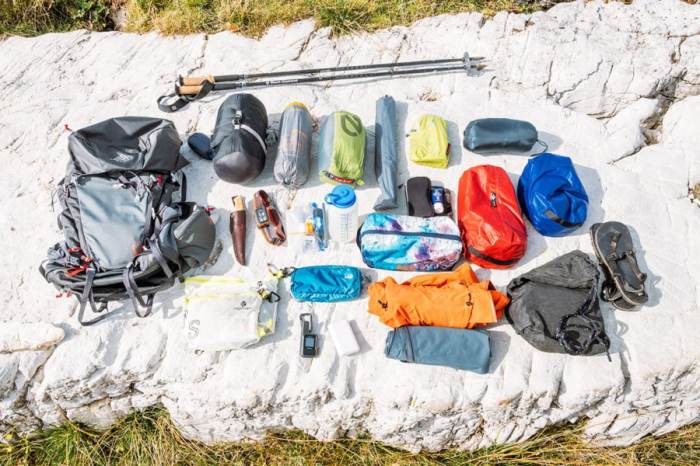
When it comes to travel, sometimes the most memorable experiences can be found off the beaten path. Exploring hidden gems and lesser-known destinations can offer a unique and authentic travel experience that is truly unforgettable. In this segment, we will delve into the allure of off-the-beaten-path adventures, share tips for discovering these hidden gems, and discuss the benefits of exploring unconventional travel routes.
Exploring Hidden Gems
- Research local blogs, forums, and travel websites to uncover hidden gems that are not on the typical tourist radar.
- Seek recommendations from locals or fellow travelers who have ventured off the beaten path before.
- Consider hiring a local guide who can provide insider knowledge and take you to lesser-known spots.
Benefits of Unconventional Travel Routes
- Escape the crowds and enjoy a more peaceful and authentic travel experience.
- Support local communities and businesses that may not benefit from mass tourism.
- Gain a deeper appreciation for the culture, history, and natural beauty of a destination by exploring off-the-beaten-path locations.
Winter Sports Travel
When embarking on a winter sports trip, it is essential to pack the right gear and be prepared for the cold weather conditions. Whether you are skiing, snowboarding, or engaging in other winter activities, having the right equipment and knowledge is crucial for a safe and enjoyable experience.
Packing Essentials for Winter Sports Trips
Before heading out on your winter sports adventure, make sure to pack the following essentials:
- Warm clothing layers (including thermal underwear, fleece jackets, and waterproof outerwear)
- Hats, gloves, scarves, and thermal socks
- Sunscreen and lip balm with SPF protection
- Snow goggles or sunglasses with UV protection
- Helmet for skiing or snowboarding
- Hand and foot warmers
- Waterproof boots or shoes
Popular Winter Sports Activities and Destinations
Some popular winter sports activities include:
- Downhill skiing in the Swiss Alps
- Snowboarding in Whistler, Canada
- Ice climbing in Iceland
- Cross-country skiing in Norway
- Snowshoeing in the Rocky Mountains
Safety Tips for Enjoying Winter Sports Adventures
It is important to prioritize safety while enjoying winter sports. Here are some tips to ensure a safe experience:
- Always wear a helmet when skiing or snowboarding
- Stay on marked trails and obey all posted signs
- Check the weather forecast before heading out and be prepared for changing conditions
- Ski or snowboard with a buddy and have a plan in case of separation
- Stay hydrated and take breaks to rest and warm up
Desert Expeditions

When embarking on desert expeditions, it is crucial to be well-prepared for the extreme conditions that come with exploring these arid landscapes. From scorching temperatures to limited water sources, surviving and thriving in the desert requires careful planning and the right gear.
Necessary Items for Desert Expeditions
- Plenty of water: Staying hydrated is key in the desert, so make sure to carry enough water to last throughout your journey.
- Sun protection: Bring along sunscreen, a wide-brimmed hat, and sunglasses to shield yourself from the harsh sun rays.
- Appropriate clothing: Opt for lightweight, breathable fabrics that provide coverage from the sun and protect you from the elements.
- Navigation tools: A map, compass, or GPS device can help you navigate the vast desert landscapes and prevent getting lost.
- Emergency supplies: Pack a first aid kit, signaling devices, and extra food in case of emergencies.
Surviving and Thriving in Desert Environments
- Stay cool: Seek shade during the hottest parts of the day to avoid heat exhaustion or heatstroke.
- Plan your travel: Avoid traveling during the peak heat hours and take breaks in shaded areas to rest and cool down.
- Know the signs of dehydration: Keep an eye out for symptoms like dizziness, rapid heartbeat, and dry mouth, and drink water regularly to stay hydrated.
- Be prepared for temperature changes: Deserts can experience drastic temperature shifts, so layer your clothing to adapt to these fluctuations.
- Respect the environment: Leave no trace and minimize your impact on the delicate desert ecosystem by following Leave No Trace principles.
Beauty and Challenges of Exploring Deserts on Foot
- Scenic landscapes: Deserts offer breathtaking views of vast sand dunes, rock formations, and unique flora and fauna that can only be experienced on foot.
- Solitude and serenity: Walking through the desert allows you to disconnect from the hustle and bustle of daily life and immerse yourself in the peacefulness of the desert wilderness.
- Navigational difficulties: The lack of prominent landmarks and changing terrain can pose challenges in route-finding, requiring careful navigation skills.
- Physical endurance: Trekking through sandy terrain and under the scorching sun demands physical stamina and mental resilience to overcome the obstacles of desert hiking.
- Rewarding experience: Despite the challenges, exploring deserts on foot offers a unique and rewarding adventure that connects you to the raw beauty and vastness of these remote landscapes.
In conclusion, mastering the art of packing for hiking and trekking adventures can significantly enhance your outdoor experiences. With the right gear and preparation, you’re all set to conquer any trail or mountain that comes your way.
FAQ Resource
What are some essential items to pack for a hiking or trekking trip?
Some essential items include sturdy hiking boots, water bottles, first aid kit, navigation tools, and appropriate clothing layers.
How can I pack efficiently for varying terrains and climates?
Consider the weather conditions, pack versatile clothing, use packing cubes or compression sacks, and prioritize lightweight gear.
Why is lightweight and multipurpose gear important for long hikes?
Lightweight gear reduces strain on your body during long hikes, while multipurpose items save space and weight in your backpack, allowing for easier movement.

